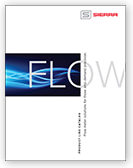Official Blog of Sierra--Let's Talk Flow!
In Search of the Perfect Sensor: Thermal Flow Meter History & Trends
Q: Your story and the birth of thermal flow measurement technology are very much intertwined. What role did you play in developing the initial concepts for thermal flow measurement?
A: Yes, you’re right, I’ve been focusing on thermal mass flow meter measurement for a very long time indeed. When I first started using this technology while at Stanford in the early ’60s getting my Ph.D. in mechanical engineering, this kind of instrument was called a “hot-wire anemometer.” That’s the name given to it by its inventor, L.V. King, in 1914. These instruments worked successfully for fluid mechanics research, but were fragile and intended for laboratory use. I worked in this industry and learned that there is an unfulfilled and far bigger need for thermal mass flow meters that are rugged and intended for general industrial applications.
In a few years following the conception of this idea, the basic sensor design had evolved into what is used today by most manufacturers—a self-heated platinum RTD winding on a ceramic mandrel that is encased in a rugged sealed metallic tube. In the usual configuration, a second sensor of similar design, but not self-heated, is located adjacent to the heated sensor and measures the temperature of the fluid. The instrument’s electronics maintain the difference in temperature between the heated sensor and the temperature sensor at a constant value, and the wattage required to do so gives you the mass flow output of the instrument. In almost all applications the fluid is a gas because the measurement sensitivity for liquids is too low.
So, getting back to your question, I guess I played a role in the industrialization of the technology. Initially, thermal dispersion mass flow meters were configured as insertion meters. I also played an early role in adapting the technology to the more prevalent and more accurate in-line configuration with built-in flow conditioning. Along with other pioneers n the industry, I also was active in convincing the marketplace that thermal dispersion flow meters do indeed directly measure mass flow rate. Believe me, it took years for this truth to gain the acceptance we now take for granted.
Q: Going forward, what do you see as the most important trends in the area of flow measurement and control? How do you see broader trends in technology and applications influencing R&D efforts in the future?
A: In the flowmeter business there is an inexorable drive for higher accuracy. This is true because higher accuracy means customers can deliver their product with higher quality, less waste, and consequently higher profit. Thermal dispersion mass flowmeters have high repeatability, and, therefore, if the conditions in the field are close to those for which it was flow calibrated, high-end instruments have good accuracy. On this basis, most manufacturers specify an accuracy of about 1 percent of full scale. But, in the real world, the process temperature, process pressure, and ambient temperature in the field usually change—and accuracy suffers. As is to be expected, accuracy is also compromised if the gas itself changes. All of this is why the holy grail of our industry has always been: How is high accuracy maintained when things change?
I’ve been working on this problem for more years than I’d like to say. It has been a lot of hard work and long hours. I finally finished late last year, and Sierra introduced an advanced thermal dispersion mass flowmeter that manages these changes and delivers an accuracy of 0.5 percent of reading over the flow range of 50-100 percent of full scale, even when field conditions change (Figure 2). The new flowmeter is also multivariable (measures mass flow rate, process temperature, and optionally process pressure) and has a multi-gas capability for over 80 gases and gas mixtures that have their properties stored in embedded memory. This latter feature means it can handle applications where the gas composition is changing.
The new flowmeter is based on four technologies: The DrySense sensor that I mentioned before; a sensing head that has no flow interferences; the QuadraTherm design that has four temperature sensors instead of the traditional two; and the qTherm algorithm set that manages changing conditions and gas selection.
I think this new flowmeter is the next big thing in our industry.
Read more of Dr. Olin’s comments about Sierra’s humble beginnings, and be sure to contact us to find out which flow meter solutions are right for your company.
Maryadine Washington, Mar-Com Manager
Sierra Instruments

 Go to Autotest Division >
Go to Autotest Division > DOWNLOAD
DOWNLOAD